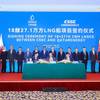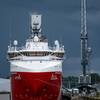Global LNG Demand 16% Up in Q2
Global liquefied natural gas (LNG) demand was 86 million tonnes (mt) in the second quarter, compared with 74 mt in the second quarter of 2018, an increase of 16%, said GasLog Ltd.
The Monaco-headquartered international owner, operator and manager of liquefied LNG carriers said that higher European imports (up 110% year-on-year) accounted for most of the growth, while demand from Northeast Asia (Japan, China, South Korea and Taiwan) was flat year-on-year, according to Poten.
Natural gas prices were at multi-year lows in the second quarter of 2019 as the leveling off in demand growth from key LNG consumers in Northeast Asia coupled with elevated inventories and new LNG supply depressed LNG prices in Asia and Europe.
However, low European gas prices and rising carbon prices have incentivized coal-to-gas switching in power generation, with Platts reporting that Germany’s and Italy’s gas-fired power generation has increased 54% and 37%, respectively, in 2019 to date. Global LNG demand for 2019 is estimated at 351 mt, an increase of over 37 mt, or 12%, over 2018, according to Wood Mackenzie.
Global LNG supply totaled 87 mt in the second quarter of 2019, an increase of 13 mt or 17% over the second quarter of 2018, principally driven by new supply additions in the U.S., Australia and Russia, according to Poten.
Wood Mackenzie estimates that 2019 supply will be 365 mt, or 38 mt (12%), higher year-on-year as 2018’s supply additions continue to ramp up production and new projects begin production in the U.S. and Australia.
The second quarter also saw significant additions to future supply growth as Cheniere reached a final investment decision (FID) on Sabine Pass Train 6 while Anadarko Petroleum took FID on Mozambique LNG (Area 1), in aggregate representing 17 mt of new liquefaction capacity according to Wood Mackenzie. In 2019, nearly 34 mt of new liquefaction capacity has reached FID to date.
Headline spot rates for tri-fuel diesel electric (TFDE) LNG carriers (LNGCs) averaged approximately $49,000 per day in the second quarter of 2019, compared to $58,000 per day in the second quarter of 2018, as reported by Clarksons.
The year-over-year decline in headline TFDE spot rates is primarily attributed to the low global natural gas prices referenced above, which limited opportunities for inter-basin LNG trading, start-up delays of new liquefaction projects, particularly in the U.S., as well as fleet growth.
Despite these headwinds, 18 charters greater than 6 months in duration were fixed during the second quarter of 2019, compared with 20 in the first quarter and 24 in the second quarter of 2018.
Poten currently estimates the one-year time charter rate for TFDE LNGCs at $85,000 per day as compared with their headline spot rates of $60,000 per day, which may indicate a potentially tightening shipping market in the quarters ahead as customers look to secure their shipping ahead of the seasonally strong winter months and through 2020.
"We expect multi-month and multi-year chartering activity and shipping rates to increase from current levels during the second half of 2019 and into 2020, with the magnitude and duration dependent on the pace and location of demand growth, the continued ramp-up in new LNG supply additions and cooling and heating demand during the Northern Hemisphere summer and winter, respectively. In 2021 and beyond, we continue to see a balanced market for LNG shipping relative to supply and demand for the LNG commodity," said GasLog.
As of July 11, 2019, the LNG fleet and orderbook (excluding floating storage and regasification units (FSRUs) and vessels with capacity below 100,000 cbm) stood at 498 and 109 vessels respectively, as estimated by Poten. Of the LNGCs in the orderbook, 63, or 58%, are chartered on multi-year contracts.
There have been 25 vessels ordered thus far in 2019, including nine during the second quarter, and against a total of 63 for all of 2018, suggesting the pace of newbuild ordering has declined.











